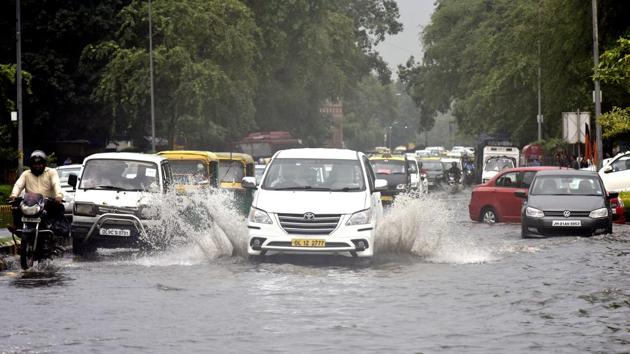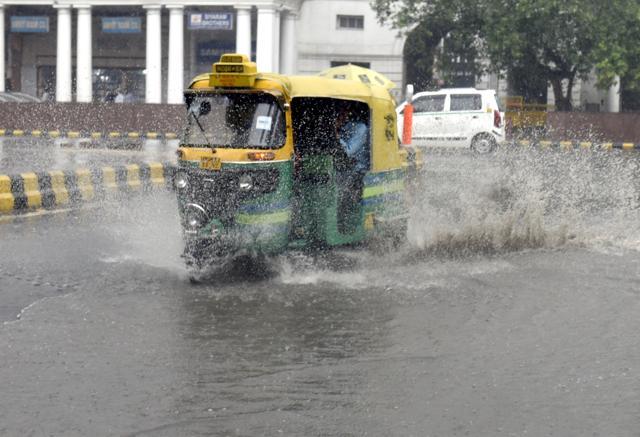Waterlogging fears put Delhi on the edge, ‘cosmetic’ preparations may not help
The saga of poor arrangements by civic agencies continued this year as the pre-monsoon showers led to a jam that stretched into hours near the Shahdara railway underpass.
Monsoon is eagerly awaited in Delhi. But it is also equally dreaded due to the waterlogging and traffic jams.

To save commuters from the monsoon mess this time, traffic police had flagged a list 370 waterlogging prone places to the Public Works Department, Delhi Jal Board, Municipal Corporation of Delhi, Northern Railway and other agencies.
The agency also highlighted over 150 perennial problem points that have been witnessing waterlogging for over five years. These areas included Azad Market Chowk (Rani Jhansi Road), Defence Colony Flyover, Laxmi Nagar Metro Station (Vikas Marg), Kamla Market roundabout, AIIMS underpass and Adhchini T-point.
To initiate action at these points, Lieutenant-Governor Anil Baijal directed officials of all concerned departments to lay down a system to deal with waterlogging so that there are no complaints of dysfunctional pumps or absence of authorised manpower during emergency.
While the authorities claim to have made all arrangements, no joint inspection has been conducted done so far, traffic officials said. “Our staff said that the repair work is being carried out actively at many points but a joint inspection will help in identifying areas that still need attention,” senior traffic police officials said.
Chaos at underpasses
Waterlogging at underpasses has been a problem for several decades now.
In September 2016, the underpass connecting Zakhira to Inderlok was inundated in chest-high water and five DTC buses were stranded there. The drivers said that they had miscalculated the water level and nearly 60 passengers were stuck in the buses for nearly an hour before they were rescued. The evacuation took over two hours and the police had to use cranes to move the buses.
The saga of poor arrangements by civic agencies continued this year as the pre-monsoon showers led to a jam that stretched into hours near the Shahdara railway underpass.
As per the agencies, 1447 pumps have been installed at vulnerable locations to avoid waterlogging this season. But other than installing these pump sets (which often falter when demand is high), the agencies do not have any action plan.
According to Dr S Velumurugan, senior principal scientist from the Central Road Research Institute, the chances of waterlogging are high when the city gets continuous rain (between 2- 2.5 cm) stretching over hours.
“But in a city like Delhi such a situation arises only in peak monsoon. And if waterlogging is taking place on other days too, it reflects the poor preparedness of the agencies. It means that the drainage system is either absent or choked,” he said.
According to him, there are certain underpasses which are designed very well such as the one near the under-construction Signature Bridge in North Delhi. “Ideally, pipelines of a minimum 2.5cm diameters should be laid at the underpasses and these should be cleaned regularly to avoid clogging,” he added.
Preparations
The traffic police have arranged for cranes to remove vehicles that break down due to waterlogging on the roads. These cranes will also help in removing trees that break during heavy rains.
“We have also pressed into service quick response teams (QRT) on motorcycles and vans to inspect waterlogging points in different parts of the city every morning and evening. These teams give us feedbacks that we have been forwarding to the concerned civic departments,” said Garima Bhatnagar, joint CP (Traffic).
The PWD and MCD have also formed teams for regular visits to affected areas. “We are more concerned about the underpasses in city at Moolchand, AIIMS, Minto Road and Zakhria. We are closely watching the preparations at 27 such points,” a senior official said.
“In the case of water logging, people can send complaints through WhatsApp (8130188222) and email ( monsoondelhi2017@gmail.com). They can also contact the toll free number (1800118595),” said SK Srivastava, engineer in chief, PWD.

Area of difficulties
According to experts, many of Delhi’s natural storm drains are ‘missing’ and probably levelled to build shops and parking lots. Those that remain are being used to carry domestic sewage and industrial waste.
In 2015, a committee was formed by the National Green Tribunal to conduct a survey using Delhi’s drainage map of 1976. The committee found that 44 of 201 natural drains were missing.
“Some drains were found later but a majority are still missing. If these drains had been in place, there would have been no waterlogging,” said Manoj Misra, convener, Yamuna Jiya Abhiyaan.
However, there is no denying the fact that the civic agencies take cognizance of the situation only at the last minute, he added further.





